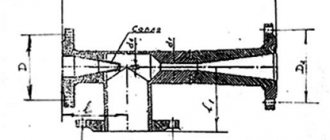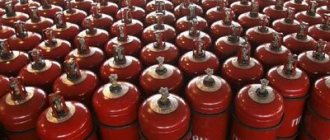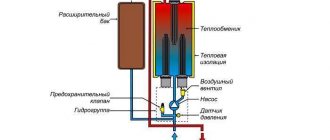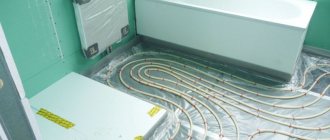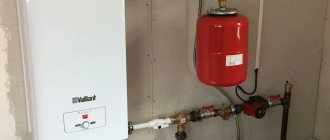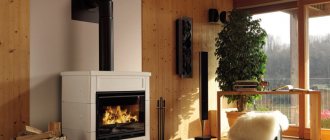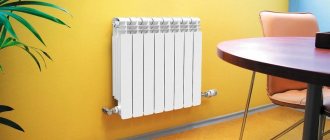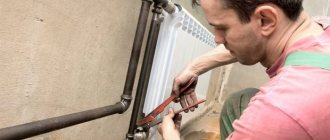To keep your home warm, it is important to properly develop a heating scheme. One of the components of its effectiveness is the connection of heating radiators. It doesn’t matter whether you are going to install cast iron, aluminum, bimetallic or steel radiators, it is important to choose the right way to connect them.
The way the radiator is connected affects its heat transfer
Why is the return hotter than the supply?
When heated, the liquid increases in volume, the excess enters the expansion tank. Since the heating system is completely filled with liquid, the hot coolant displaces the cold coolant, which returns to the boiler, where it is heated.
Interesting materials:
How long can stool be stored on Calprotectin? How long can flounder be stored in the refrigerator? How long can Nazivin drops be stored after opening? How long can crucian carp be stored in the freezer? How long can French fries be stored? How long can kefir be stored outside of the refrigerator? How long can bread be stored in the refrigerator? How long can bread be stored? How long can hops be stored? How long can Chinese tea be stored?
Is the water supply located above or below?
The main water pipeline enters the contour of a residential building and ends with a gate valve. In-house networks provide hot water to all consumers.
Through a set of vertical pipelines (risers), the coolant is distributed among the floors. Two types of wiring are used: one-pipe and two-pipe.
The choice of scheme depends on the planning decisions of the residential building:
- The option of supplying water “from below” is used in low-rise buildings. In high-rise buildings with more than nine floors, the coolant is supplied “from above”. In this case, sufficient hot water pressure is ensured on the upper floors.
- In houses with more than eighteen floors, bottling is used “from below”, but the heating system is divided into two autonomous zones. In the upper zone, excess pressure ensures the supply of coolant to the top floors.
- In the old housing stock there are houses that do not have circulation risers - “dead-end systems”. Saving pipes comes at the cost of inconvenience: when the water supply is weak, the water cools down and you have to drain some of the water.
Upper
The most common amateur serve. With certain skills, the top serve can be served as a power serve, a twist serve, or even a gliding serve.
Feed elements:
- Take a position . If you are right-handed, your left foot is in front. If left-handed - right-handed. The body weight should be transferred to the supporting leg. To the right - if you are right-handed, to the left - if you are left-handed. Feet shoulder width apart. Straighten your body in line with your legs. You must look exactly at the court - this is how we set the direction of the ball.
- Prepare the ball for hitting . Extend your straight arm with the ball forward to approximately chin level. Keep eye contact with the ball. The striking arm is placed behind the back and bent at an angle of 45 degrees. Posture is straight, shoulders straight. The ball lies flat on the palm.
- Take aim . Assess the situation on the site: which places are the most vulnerable, where to hit and where not to. Try not to hit mindlessly.
- Toss the ball . The optimal height is considered to be 30-40 cm, but each player has his own comfortable throw height. It is important that the ball is thrown straight up and slightly forward. It should not rotate around its axis. Otherwise, it will be difficult to hit it, and after being hit, it may twist and fly away to a completely different place than planned. Always throw the ball at the same point.
- Swing yourselves . A slight movement of the striking hand back. We arch the body, as in an attacking blow. Don't stick out your brush! Let's not squat! The movement is done on straightened legs. Shift your body weight to your forward leg. Breathe in.
- Hit it . The blow should hit the center of the ball with the center of the palm. The fingers are spread out for the greatest coverage area. The hand is rigidly fixed in the wrist at the moment of impact. Do not follow the ball with your hand. Follow with your body. Exhale.
Important ! Do not make unnecessary movements when swinging! The more such movements, the greater the likelihood of error. The hand is not protruding, but continues the arm perpendicular to the floor!
The girl holds the ball and aims for the top serve. Pay attention to the hands and the height for throwing the ball.
Elements of the top serve
The blow should be whippy and with a straight hand. When hitting, the hand should not be moved to the side - because of this, control over the ball is lost.
The kick occurs when the ball is at the highest point that the player can reach with a straight arm.
Another common mistake is crouching when hitting. From the outside, it looks like crouching players have an effective serve, but such a serve is extremely unstable ! The fact is that by squatting, the server adds unnecessary amplitude to the swing. Because of this, it is more difficult to catch the right moment, and the ball is struck either too early - then the flight of the ball is unpredictable, or too late - such a serve goes into the net. Do not squat when serving, otherwise it will be difficult to relearn later!
Operating principle of the elevator unit
Heating boiler connection diagram.
The water that arrives and has high temperatures enters the elevator unit. It operates on the principle of an injector, only it uses water instead of air. A coolant with high pressure and temperature passes through the elevator nozzle, then the return water is recirculated in the heating system. Thus, the temperature of the mixed water flow is the same as that available in the batteries, and as for the excess water that entered but has already cooled, it goes into the return line. According to experts, this heating system is the most effective.
The heating unit has valves for heating an apartment building (the layout varies; only the entrance can be used). Such a system is possible when a collector is installed, there are several valves on it. It is also possible to place a heat meter at the entrance to the house; it can be on the house or on a separate entrance.
DHW distribution in the apartment
In-house wiring serves to deliver hot water to all distribution points. Apartments, as a rule, have one or two hot water connections from common risers.
The valves at these inlets serve as the boundary between areas of responsibility; after the valves, the owner of the apartment is responsible for the operation of the water supply system.
The number of disassembly points varies individually; it is not uncommon to have two toilets, bidets, showers, washing machines and dishwashers. When designing internal wiring, it is necessary to take into account not only the number of disassembly points, but also the individual characteristics of household appliances.
In practice, two wiring methods are used:
- Series or tee circuit: A main pipeline is laid around the perimeter of the apartment, all water consumers are connected to it in series. The diameter of the main pipe must exceed the diameters of the auxiliary pipes.
Tees are used to connect plumbing fixtures and household appliances. This installation is suitable for small apartments. If there are a large number of consumers, the water pipeline becomes too long and the water pressure may not be enough. - Collector circuit. For larger apartments, a collector circuit is applicable. The main difference between this option is the presence of a collector pipe; water flows into it from a common riser.
Plumbing and household appliances are connected to the collector. The volume of the collector must ensure the simultaneous operation of all consumers.
Advantages of the collector circuit:
- the same inlet water pressure is ensured for all consumers;
- the ability to dismantle an individual consumer without disconnecting the entire water supply.
Flaws:
- high cost of installation;
- placement of the collector requires a separate space.
For any apartment wiring scheme, the diameters of the pipelines should not exceed the diameter of the common riser, otherwise the water supply to other apartments will be disrupted.
Where to put radiators
Traditionally, heating radiators are placed under windows, and this is no accident. The rising flow of warm air cuts off the cold air that comes from the windows. In addition, warm air heats the glass, preventing condensation from forming on it. Only for this it is necessary that the radiator occupies at least 70% of the width of the window opening. This is the only way the window will not fog up. Therefore, when choosing the power of radiators, select it so that the width of the entire heating battery is not less than the specified value.
How to place a radiator under a window
In addition, it is necessary to correctly select the height of the radiator and the location for its placement under the window. It must be placed so that the distance to the floor is around 8-12 cm. If you lower it lower, it will be inconvenient to clean, if you raise it higher, your feet will be cold. The distance to the window sill is also regulated - it should be 10-12 cm. In this case, warm air will freely go around the obstacle - the window sill - and rise along the window glass.
And the last distance that must be maintained when connecting heating radiators is the distance to the wall. It should be 3-5 cm. In this case, rising currents of warm air will rise along the back wall of the radiator, and the rate of heating the room will improve.
Breakdowns and malfunctions
Typical DHW malfunctions include:
equipment failure;- noise in the system operation;
- the temperature of heating devices is below normal;
- weak hot water pressure;
- temperature spread of the coolant across the floors of the house;
- leaks in connections;
- corrosion of pipelines and shut-off valves.
Noises, as a rule, are caused by vibration of incorrectly installed pumps, wear of electric motor bearings, loosening of pipelines, and failure of control valves.
A decrease in the temperature of heating devices is caused by air pockets in the devices themselves, misalignment of the elevator unit, blockages and violation of thermal insulation in heating risers.
Low water pressure in the absence of blockages is most often caused by malfunctions of the booster pumps. Timely maintenance increases the reliability of the heating system.
About the heating system of a multi-storey building
The heating system of a house is usually single-pipe; the spill is either upper or lower. As for the return and supply, they can be located in the basement, but it is possible that the return is in the basement and the supply is located in the attic. The movement of water in the risers can be parallel and go from top to bottom, or counter-movement and go from bottom to top (in this regard, what matters is what heating scheme was used in the house).
There are risers that are used with a counter coolant; they can also be a passing one. If the heating scheme of the house is exactly like this, then in any system there is a functioning heated towel rail riser (in this case, the system can have either an open water intake or a closed one).
The number of sections and size of heating radiators are very important. Such parameters must be determined through calculations as the water in the coolant cools. In this regard, there is one good piece of advice: if you want to replace the radiators with newer and more modern ones, then you should not use the services of friends, since you need to take into account the progress and cooling of the coolant. In this case, it is recommended to use the services of a house maintenance company, and you should not throw away the jumpers, since the company is interested in restoring them.
Thus, it becomes clear that a multi-storey building is heated using a rather simple, but very effective system. However, if any failures occur, you should not carry out repairs yourself (especially if you do not have the appropriate training). In any case, you must definitely call the technicians from the service company, who, as a rule, fix all problems in the shortest possible time. Masters use the following tools:
- pipe (gas) wrench;
- adjustable wrench;
- pipe bender;
- crimping pliers.
With such tools, all problems are quickly eliminated.
Heating system wiring.
Wiring is the layout of heating devices and the pipes connecting them. The efficiency of the heating system, its efficiency and aesthetics largely depend on it (the wiring). The choice of heating layout depends on the size of the house and its design features, as well as on the type of heating system.
Single-pipe water heating system for a multi-storey building
In multi-storey buildings, such a system is often used; a steel pipe is used as the main material (in private heating systems, the use of polypropylene or metal-plastic is acceptable).
- the design of the system and its design are calculated in accordance with SNiP for laying pipelines;
- sections of the main line running outside or in the basement are insulated so that the heat does not go to waste;
- buildings use a vertical single-pipe system - a cheap and effective heating option;
- design and calculations are carried out at the construction stage - the optimal option, diagrams and drawings with calculations related to heating are approved by the relevant authorities before the start of construction;
- Before putting into operation, pressure testing and commissioning are carried out.
What does a single-circuit flow-through heating circuit look like?
In multi-storey buildings for various purposes within a populated area, heating is carried out centrally, i.e. the house has a heating main inlet and water valves, one or more heating units.
- the heating unit is located in a separate room, locked for safety;
Photo 1. Conventional image of what a single-circuit heating system looks like, indicating the coolant temperature throughout the entire circuit.
- water valves come first;
- after the valves, mud traps are installed - filters in which foreign inclusions in the coolant are retained: dirt, sand, rust;
- then follow the DHW valves installed on the return and supply (or at the beginning and end of the circuit).
- boiling water from the thermal power plant enters the elevator unit, where it is mixed under pressure with water that is already circulating in the system, resulting in water with a temperature of about 70 ° C, which enters the radiators;
- excess cooling coolant goes into the return line;
- Heat distribution occurs using valves or a collector with valves for each part of the house.
Their purpose is to provide hot water supply, which can be supplied from the supply or return. In winter, the coolant arrives very hot, much more than 100 ° C (boiling does not occur due to high pressure in the pipeline).
Reference! In a single-pipe system, a similar principle is implemented by supplying hot water from the end of the circuit, where the water has already cooled to an acceptable temperature. Accordingly, if the supply temperature from the main is reduced, the DHW changes the source to the beginning of the circuit.
Such water cannot be used for domestic needs, so the supply from the return line is activated, where the temperature has already been reduced to an acceptable level. In the autumn-spring period, when heating is less intense, the return water turns out to be too cool, so the hot water supply is supplied from the supply.
One of the convenient and common schemes is an open water intake:
The return and supply are usually located in the basement, sometimes they are separated: the return is in the basement, and the supply is in the attic.
The advantage of a single-pipe system is considered to be low cost, and this is the only advantage of this system. With the spread and improvement of the two-pipe system, the single-pipe system is used less and less in apartment buildings.
In private homes, the efficiency and simplicity of the design are valued higher - it can be assembled with your own hands, easily maintained and made energy independent.
- the need to accurately calculate the diameters of the pipes of the main pipeline and branches;
- in radiators at the end of the circuit the temperature will be lower, accordingly you will have to think about increasing the volume of heating devices;
- for the same reason, the number of radiators on one branch will be limited, since uniform heating of a large number is impossible.


